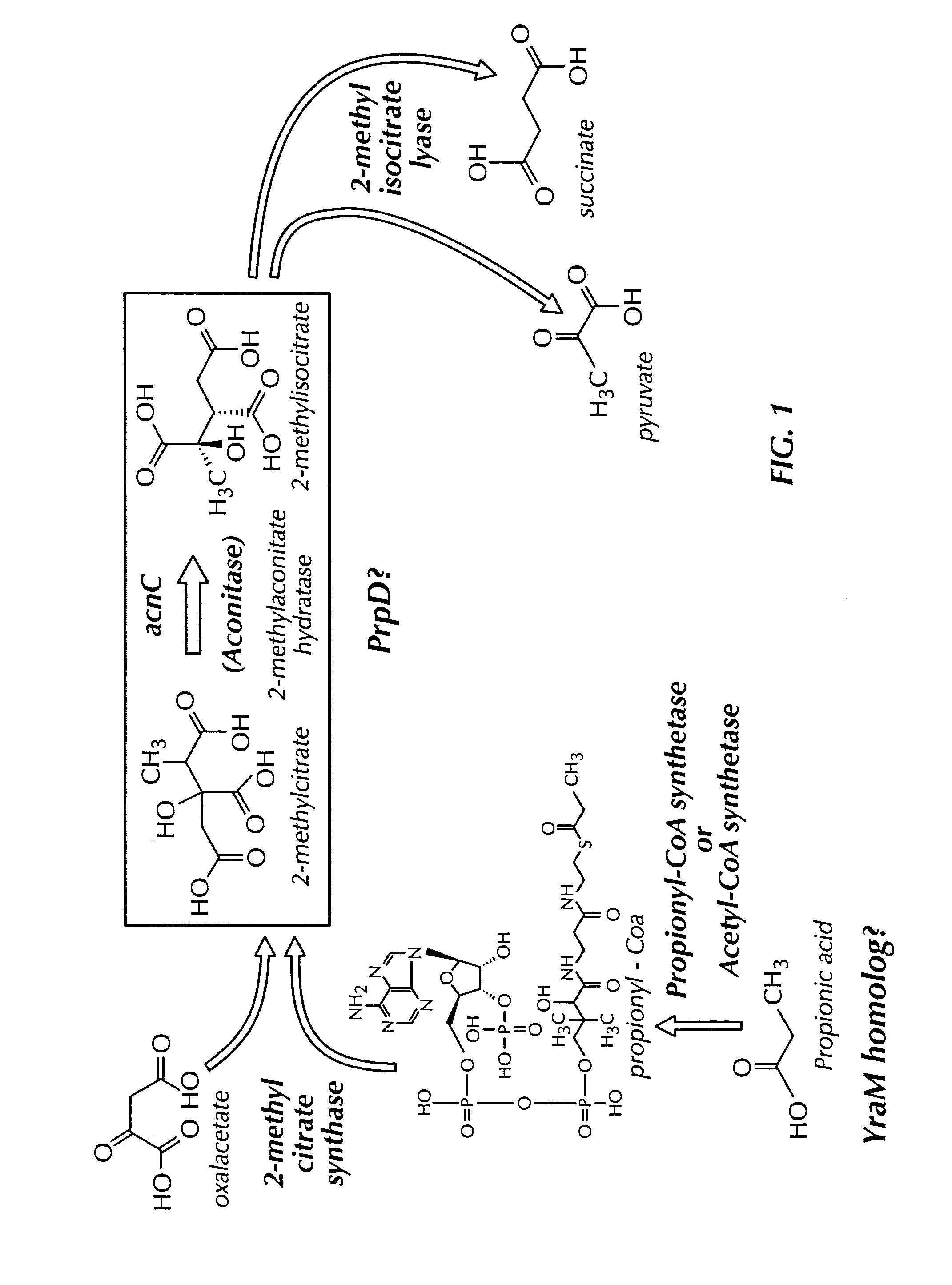Aconitase
- Summary
- Abstract
- Description
- Claims
- Application Information
AI Technical Summary
Benefits of technology
Problems solved by technology
Method used
Image
Examples
example 1
Isolation of the Aconitase C Gene from P. aeruginosa
[0035]The genome of P. aeruginosa wildtype strain 01, a mucoid producing strain, designated herein PA01 was subjected to PCR to obtain a 900 base pair aconitase C encoding fragment. The forward primer was GTNGGNACNGAYTCNCAYACN (SEQ ID NO:1) and the backward primer was NCKNCCYTCRAARTTNCKRTT (SEQ ID NO:2). The amplified fragment was sequenced and the amino acid sequence encoded was deduced. The complete nucleotide sequence and deduced amino acid sequence are shown in FIG. 2A.
[0036]The position of the aconitase C encoding gene in P. aeruginosa is compared to the location of the corresponding encoding sequence in S. typhimurium and E. coli in FIG. 2C. E. coli and S. typhimurium catabolize propionate using proteins encoded by the prpBCDE operon (prp operon). These prp operons have been shown to contain a set of genes—prpR, prpB, prpC, prpD and prpE. The prpD gene in these bacteria has been proposed to encode a protein with 2-methylcitr...
example 2
Disruption of the Aconitase C Coding Sequence
[0038]The approximately 900 base pairs of the aconitase C insert obtained in Example 1 was amplified by PCR from the PA01 genome using the primers GTGGCACCGACAGCCATAC (SEQ ID NO:3) and GCGCCCGTCGAAGTTGCGGTT (SEQ ID NO:4). The amplified fragment was ligated into pBluescript-2 (KS+) (Stratagene) which had been cleaved with EcoRV and treated with tack DNA polymerase and dTTP to form intermediate plasmid pBSacnC. An approximately 1 kb DNA that encodes gentamicin resistance (GmR) was isolated from pUCGm described in Schweizer, H. D., Biotechniques (1993) 15:831–834 by digesting with SmaI. This amplified segment was cloned into the StuI site which resides in the acnC coding sequence in pBSanC to generate pBSacnCGm. The approximately 2 kb DNA fragment which contains the acnC sequence which was disrupted with the GmR cassette was isolated by treating this plasmid with HindIII and PstI and filled in with Klenow and dNTP's. This fragment was ligate...
example 3
Effects of acnC Gene Disruption
[0040]The effect of acnC gene disruption on various virulent activities of PA01 were determined.
[0041]Exotoxin A production, determined by Western analysis of stationary phase supernatants did not show any change. However, hemolytic activity (tested by zone clearance on blood agar plates); proteolytic activity (tested by zone clearance on milk agar plates); elastase activity (tested by zone clearance on 2XYT-elastin plates); pyoverdin production (tested by pigment production on F agar plates); and pyocyanin production (tested by pigment production of P agar plates) were all diminished substantially.
[0042]When tested for growth on various carbon sources, no difference was observed when glucose, glutamate, citrate, isocitrate, succinate, acetate, pyruvate, butyrate, hexonate, or glyoxalate was used as a carbon source. However, although the wildtype could grow well on propionate, pentanate and the combination of glyoxalate and propionate as carbon sources...
PUM
| Property | Measurement | Unit |
|---|---|---|
| Fraction | aaaaa | aaaaa |
| Concentration | aaaaa | aaaaa |
Abstract
Description
Claims
Application Information
 Login to View More
Login to View More - R&D Engineer
- R&D Manager
- IP Professional
- Industry Leading Data Capabilities
- Powerful AI technology
- Patent DNA Extraction
Browse by: Latest US Patents, China's latest patents, Technical Efficacy Thesaurus, Application Domain, Technology Topic, Popular Technical Reports.
© 2024 PatSnap. All rights reserved.Legal|Privacy policy|Modern Slavery Act Transparency Statement|Sitemap|About US| Contact US: help@patsnap.com










